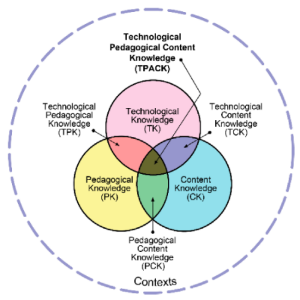
TPACK Venn Diagram

Understanding the TPACK Framework
[size=150] [size=200]Explanation of the set diagram representation of the TPACK model:[/size][/size][br][br][size=150]1.[b][color=#1e84cc] Content Knowledge (CK)[/color][color=#38761d]:[/color][/b] This set represents the knowledge of the subject matter or content that educators possess. It includes the deep understanding of the concepts, principles, theories, and skills specific to a particular domain or discipline.[br][br]2.[color=#f1c232][b] Pedagogical Knowledge (PK[/b][/color]): This set represents the knowledge of effective teaching practices and instructional strategies. It includes understanding how to design learning experiences, engage students, manage classrooms, assess learning, and provide feedback. Pedagogical knowledge encompasses a wide range of teaching methods, approaches, and techniques.[br][br]3. [b][color=#d5a6bd]Technological Knowledge (TK):[/color][/b]This set represents the knowledge of various technologies and how they can be used to enhance teaching and learning. It includes familiarity with digital tools, software applications, online resources, multimedia, and other technology-based resources. Technological knowledge involves understanding how to select, integrate, and leverage technology in educational contexts.[br][br]The TPACK model recognizes that the intersection of these three sets is where effective technology integration in education occurs. The overlapping regions represent the integration and intersection of knowledge:[br][br]- [color=#6aa84f][b]CK and PK Intersection (CK-PK):[/b][/color] This intersection represents the knowledge and strategies for teaching the content effectively without the use of technology. It encompasses traditional instructional methods, lesson planning, assessment techniques, and classroom management strategies.[br][br]- [color=#9900ff][b]CK and TK Intersection (CK-TK):[/b][/color] This intersection represents the knowledge of how technology can be applied to enhance the understanding and delivery of content. It involves using technology tools and resources to explore, illustrate, and communicate concepts and ideas within the specific content area.[br][br][color=#ff00ff][b]- PK and TK Intersection (PK-TK):[/b][/color] This intersection represents the knowledge of how technology can be used to support and enhance pedagogical practices. It involves understanding how to design and implement technology-integrated lessons, activities, assessments, and collaborative learning experiences.[br][br]- [color=#274e13][b]CK, PK, and TK Intersection (CK-PK-TK): [/b][/color]This central intersection represents the ideal balance and integration of content, pedagogy, and technology knowledge. It represents the expertise required to effectively design and implement technology-enhanced learning experiences that align with the content goals, pedagogical strategies, and the affordances of technology.[br][br]By understanding and leveraging the overlapping regions in the TPACK model, educators can develop the knowledge and skills necessary to integrate technology effectively in their teaching practices, promoting meaningful and engaging learning experiences for students.[/size]